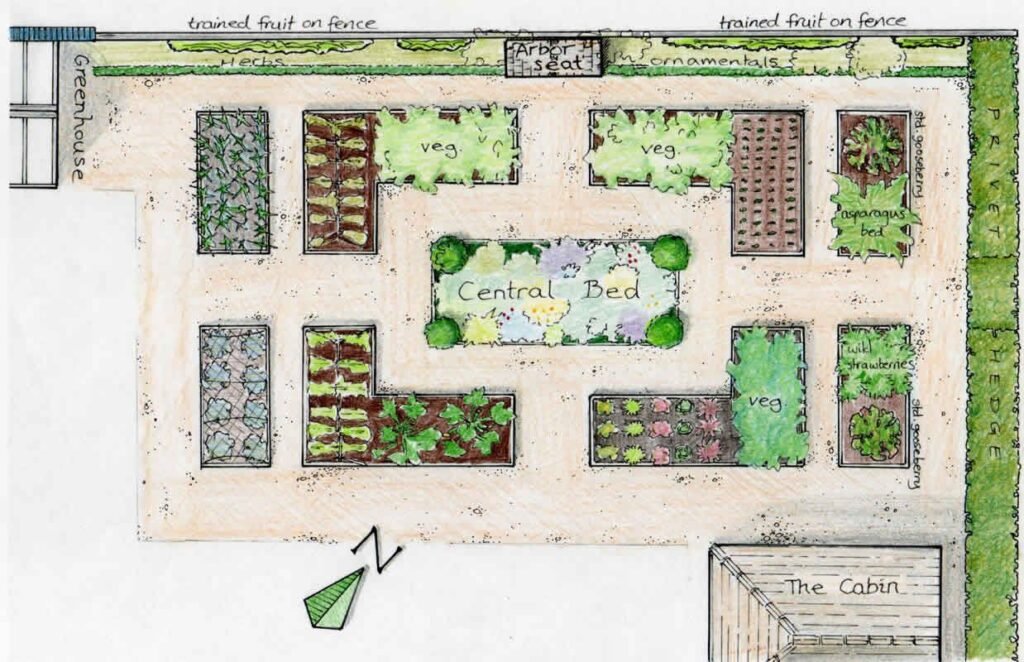Designing a raised bed vegetable garden layout can seem like a daunting task, especially for beginners. However, with the right guidance and a bit of creativity, anyone can create a beautiful and productive garden space. In this comprehensive guide, we’ll walk you through everything you need to know to design your raised bed vegetable garden layout like a pro.

Choosing the Perfect Location
Selecting the ideal location for your raised bed vegetable garden is crucial for its success. Here’s what you need to consider:
Finding Adequate Sunlight: Ensure your garden receives at least 6-8 hours of direct sunlight daily for optimal plant growth and productivity.
Soil Quality and Drainage: Test the soil quality and ensure proper drainage to prevent waterlogging, which can lead to root rot and other issues.
Assessing Available Space
Before designing your raised bed vegetable garden layout, assess the available space and consider the following factors:
Garden Size and Shape: Determine the size and shape of your garden based on available space and your gardening goals.
Accessibility: Ensure easy access to your garden beds for planting, watering, and harvesting. Consider pathways and spacing between beds.

Designing Raised bed vegetable garden layout
Once you’ve selected the location and assessed the available space, it’s time to design your raised bed vegetable garden layout. Here’s how:
Layout Planning
Sketch a rough plan of your garden layout, considering factors such as bed orientation, spacing, and companion planting.
Bed Arrangement: Arrange your garden beds in a way that maximizes sunlight exposure and airflow while allowing for efficient watering and maintenance.
Companion Planting
Implement companion planting techniques to maximize space and promote plant health. Companion plants can deter pests, attract beneficial insects, and improve soil fertility.

Plant Selection and Placement
Choosing the right plants and arranging them strategically is key to a successful raised bed vegetable garden. Consider the following tips:
Selecting Vegetables
Choose vegetables that thrive in your climate and growing conditions. Consider factors such as frost dates, temperature extremes, and sunlight requirements.
Plant Spacing
Follow recommended spacing guidelines for each vegetable variety to prevent overcrowding and ensure adequate airflow and sunlight penetration.
Maintaining Your Garden
Proper maintenance is essential for the health and productivity of your raised bed vegetable garden. Here’s what you need to do:
Watering and Mulching
Water your garden regularly, ensuring consistent moisture levels without overwatering. Apply mulch to retain soil moisture, suppress weeds, and regulate soil temperature.
Fertilizing and Pest Control
Feed your plants with organic fertilizers as needed to provide essential nutrients for growth. Implement natural pest control methods such as companion planting, handpicking pests, and using organic sprays sparingly.

FAQs (Frequently Asked Questions)
How deep should a raised garden bed be?
A raised garden bed should ideally be 6-12 inches deep, allowing for ample root growth while ensuring proper drainage.
What materials can I use to build raised garden beds?
Common materials for building raised garden beds include untreated wood, cedar, composite lumber, and galvanized steel. Avoid using pressure-treated wood, as it may contain harmful chemicals.
Can I grow vegetables year-round in a raised bed garden?
With proper planning and season extension techniques such as row covers and cold frames, you can indeed grow vegetables year-round in a raised bed garden, depending on your climate.
How do I prevent weeds in my raised bed garden?
To prevent weeds, apply a layer of mulch on the soil surface, use landscape fabric or cardboard as a weed barrier, and promptly remove any weeds that emerge.
Do raised bed gardens require less water?
While raised bed gardens typically require less water than traditional gardens due to improved soil drainage and reduced compaction, it’s essential to monitor soil moisture levels and water accordingly, especially during hot and dry periods.
What vegetables are best suited for raised bed gardens?
Vegetables such as tomatoes, peppers, lettuce, spinach, carrots, radishes, and herbs are well-suited for raised bed gardens due to their compact growth habits and shallow root systems.
Conclusion
Designing a raised bed vegetable garden layout is an enjoyable and rewarding endeavor that allows you to grow fresh, nutritious produce right in your backyard. By following the tips and guidelines outlined in this article, you’ll be well-equipped to create a beautiful and bountiful garden that you can enjoy for years to come.














